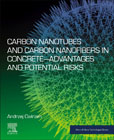
Carbon Nanotubes and Carbon Nanofibers in Concrete: Advantages and Potential Risks
Cwirzen, Andrzej
Carbon Nanotubes and Carbon Nanofibers in Concrete: Advantages and Potential Risks focuses on the application of carbon nanotubes and carbon nanofibers in traditional concretes based on Portland cement. Fundamental information is given related to the production technologies of carbon nanotubes and carbon nanofibers, as well as concretes and incorporating nanomaterials. The book also contains a section focusing on the possible negative effects of carbon nanotubes and carbon nanofibers on animals and humans. That section is entirely based on the results obtained by other parties. Carbon Nanotubes and Carbon Nanofibers in Concrete: Advantages and Potential Risks indicates benefits and possible problems related to the application of carbon nanotubes and carbon nanofibers in concrete. It is designed to be easy to access and digest for the reader, aiming to reach an audience, not only from academia, but also from the construction industry, materials producers, and contractors who might work with nanomaterials. Outlines the major properties and synthesis methods for carbon nanomaterials in concrete engineeringExplains the role of carbon nanotubes and nanofillers in creating high performance concreteAssesses the major challenges of integrating carbon nanomaterials into concrete manufacture on an industrial scale INDICE: 1 Contents 2 Abbreviations 3 Foreword 4 Introduction 5 Non-carbon-based nanomaterials 5.1 Nanosilica 5.2 Titanium dioxide nanoparticles 5.3 Nanoclay 6 Carbon-based nanomaterials 6.1 Graphite, graphene, graphene oxide, diamond, fullerenes and carbon nanobuds 6.2 Carbon nanotubes (CNTs) 6.2.1 Introduction 6.2.2 Growth mechanism 6.2.3 Applications 6.3 Carbon nanofibers (CNFs) 6.3.1 Introduction 6.3.2 Growth mechanism of CNFs 6.3.3 Applications 7 Synthesis of CNTs 7.1 Catalytic chemical vapour deposition (CCVD) 7.2 Arc-discharge (AD) 7.3 Laser ablation (LA) 8 Synthesis of CNFs 8.1 Chemical vapour deposition 8.2 Electrospinning 8.3 Arc discharge 9 Incorporation of CNTs/CNFs into concrete 9.1 Water dispersions 9.1.1 Steric repulsion (hindrance) 9.1.2 Surface functionalization 9.1.3 Effects of Ca 9.1.4 Effects of sonication 9.2 Direct synthesis on Portland cement particles 9.3 Direct synthesis on silica fume particles 9.4 Physical attachment of CNT/CNF to particles 10 Effects of CNTs/CNFs on concrete 10.1 Hydration processes and microstructure 10.1.1 CNTs/CNFs added as a water dispersion 10.1.2 Portland cement with grown CNFs 10.1.3 Cement with physically attached CNTs 10.2 Workability 10.3 Shrinkage 10.3.1 Drying shrinkage 10.3.2 Autogenous shrinkage 10.4 Mechanical properties 10.4.1 Compressive strength 10.4.2 Flexural and tensile strengths 10.4.3 Young's modulus of elasticity 10.5 Electrical properties 10.5.1 Non-conductive matrixes 10.6 Sensing capabilities 10.6.1 Piezoresistive load sensing 10.6.2 Damage detection 10.6.3 Hydration heat 10.6.4 Humidity 10.6.5 Temperature 10.7 Energy harvesting 10.7.1 Piezoelectric energy harvesting 10.7.2 Pyroelectric effect energy harvesting 10.7.3 Thermoelectric energy harvesting 10.8 Durability 10.8.1 Frost durability 10.8.2 Reinforcement corrosion 11 Possible adverse effects on humans 11.1 Carbon nanotubes (CNTs) 11.1.1 Single walled CNTs (SWCNTs) 11.1.2 Multiwalled CNTs 11.2 Carbon nanofibers (CNFs) 11.3 Release of CNTs during production and demolishing of concretes 12 Summary 13 References
- ISBN: 978-0-323-85856-4
- Editorial: Elsevier
- Encuadernacion: Rústica
- Páginas: 300
- Fecha Publicación: 01/08/2021
- Nº Volúmenes: 1
- Idioma: Inglés
